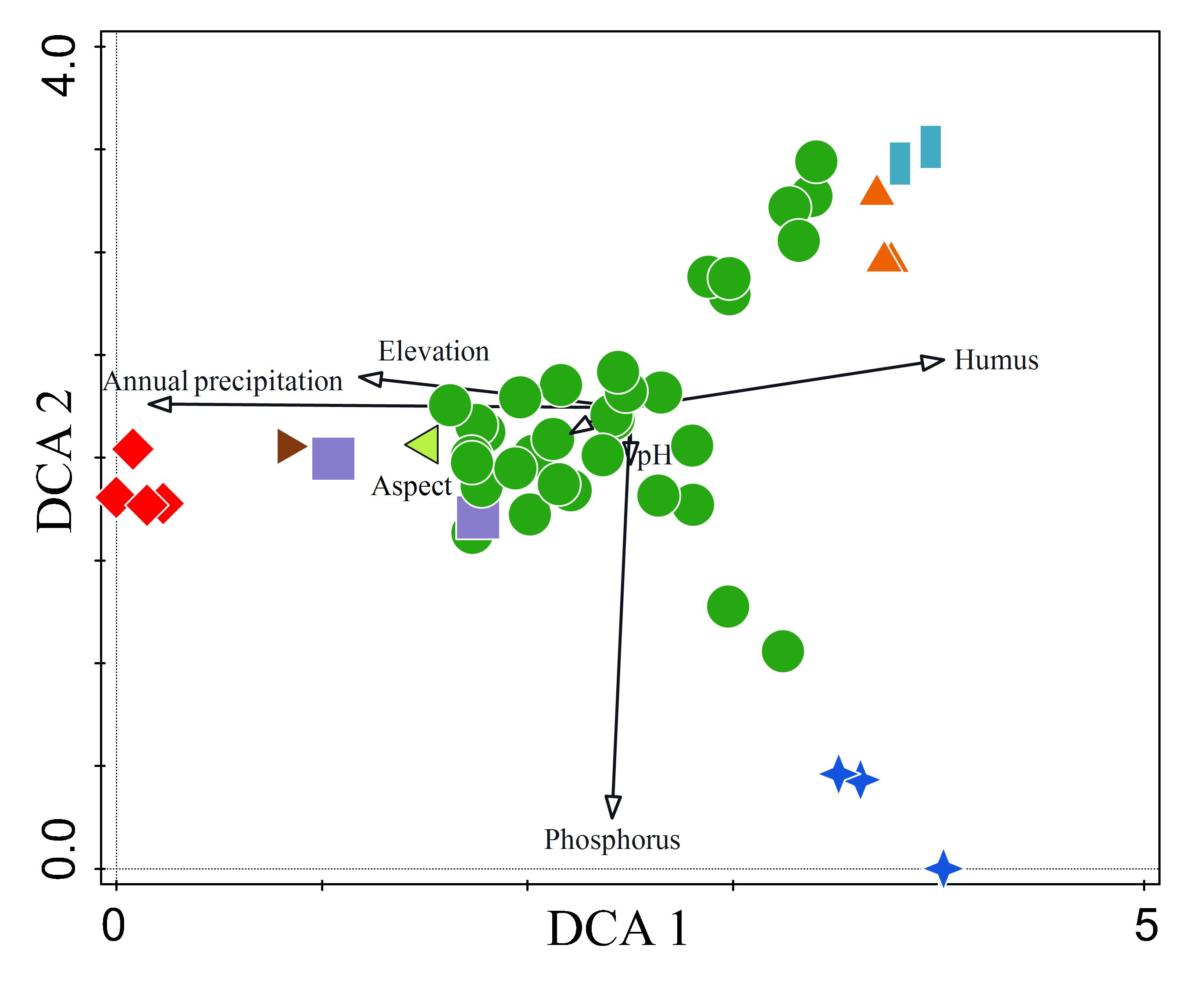Eco-coenotic analysis of pasture areas from the Danube Delta, Romania
Ključne besede:
Delta Donave, floristična sestava, travišča, okoljske spremenljivkePovzetek
Namen študije je bil raziskati floristično sestavo 12 pašnikov v delti Donave in sosednjih območjih ter analizirati razmerja med floristično sestavo in okoljskimi spremenljivkami. Vegetacijska analiza je bila izvedena na podlagi srednjih odstotnih vrednosti, ki ustrezajo lestvici, razviti po Braun-Blanquetovi lestvici - pokritost-številčnost. Za sintaksonomsko razporeditev je bilo uporabljenih 50 fitocenoloških relevej. Klasifikacija vegetacije je bila izvedena s hierarhičnim aglomerativnim združevanjem v skupine z uporabo prilagodljivega algoritma β in različnosti Bray-Curtis. Razmerje med floristično sestavo in okoljskimi spremenljivkami je bilo ocenjeno z uporabo Korespondenčna analiza detrenda (DCA) in kanonične korelacijske analize (CCA) v CANOCO. Kolinearnost med spremenljivkami je bila določena s faktorjem inflacije variance (VIF). Rezultati študije so pokazali identifikacijo petih tipov rastlinskih združb z analizo grozdov. Koncentracije humusa in skupnega fosforja so pomembno vplivale na model porazdelitve floristične sestave.
Prenosi
Literatura
Adar, S., Sternberg, M., Argaman, E., Henkin, Z., Dovrat, G., Zaady, E. & Paz-Kagan, T. (2023). Testing a novel pasture quality index using remote sensing tools in semiarid and Mediterranean grasslands. Agriculture, Ecosystems & Environment, 357, 108674.
Anamo, A., Mammo, S. & Temesgen, M. (2023). Floristic composition and community analysis of woody species in Hereje Natural Forest, southwest Ethiopia. SN Applied Sciences, 5(1), 48.
Ashton, D., Porter, S., Downie, N., Linsley, T. & Entriken, W. (2016). Radarchart: Radar chart from ‘Chart.js’. https://CRAN.R-project.org/package=radarchart.
Balyan, R. S. & Malik, R. K. (2000). Competitive ability of winter wheat cultivars with wild oat (Avena ludoviciana). Weed Science, 48(4), 610-614.
Begon, M., Townsend, C. R. & Harper, J. L. (2006). Ecology: From individuals to ecosystems. Blackwell Publishing.
Birhanu, L., Bekele, T., Tesfaw, B. & Demissew, S. (2021). Relationships between topographic factors, soil and plant communities in a dry Afromontane forest patches of Northwestern Ethiopia. PloS one, 16(3), e0247966.
Borza, A. & Boşcaiu, N. (1965). Introducere în studiul covorului vegetal (Introduction to the study of the plant carpet) [in Romanian]. Academia Republicii Populare Române.
Bouxin, G. (2005). Ginkgo, a multivariate analysis package. Journal of Vegetation Science, 16, 355–359. https://doi.org/10.1111/j.1654-1103.2005.tb02374.x
Braun-Blanquet, J. (1964). Pflanzensoziologie. Grundzüge der Vegetationskunde. Springer.
Briemle, G. & Ellenberg, H. (1994). Zur Mahdverträglichkeit von Grünlandpflanzen – Möglichkeiten der praktischen Anwendung von Zeigerwerten. Natur und Landschaft, 69, 139-147.
Briemle, G. (1996). Farbatlas Kräuter und Gräser in Feld und Wald, Stuttgart (Hohenheim): Ulmer, ISBN 3-8001-4125-6.
Briemle, G., Nitsche, S. & Nitsche, L. (2002). Nutzungswertzahlen für Gefäßpflanzen des Grünlandes. Schriftenreihe für Vegetationskunde, 38, 203-225.
Calota, A. M. & Patru-Stupariu, I. (2019). Pasture resilience towards landscape changes: Assessing pastures quality in the context of land-use and land-cover changes in Romania. European Journal of Geography, 10(2).
Carreira, E., Serrano, J., Lopes de Castro, J., Shahidian, S. & Pereira, A. F. (2023). Montado mediterranean ecosystem (Soil–Pasture–Tree and animals): a review of monitoring technologies and grazing systems. Applied Sciences, 13(10), 6242.
Chifu, T., Irimia, I. & Zamfirescu, O. (2014). Diversitatea fitosociologică a vegetaţiei României. II. Vegetația erbacee antropizată. A. Vegetația pajiștilor (The phytosociological diversity of Romania's vegetation. II. Anthropogenic herbaceous vegetation. A. Grassland vegetation) [in Romanian]. Institutul European 659 pp.
Chirilă, S. D., Răileanu, Ș., David, L. O., Covaliov, S. & Doroftei, M. (2024). An analysis of plant palatability on pastures of the delta: Case study, Danube Delta area, Romania. Notulae Botanicae Horti Agrobotanici Cluj-Napoca, 52(1), 13568-13568.
Chytrý, M., Tichý, L., Hennekens, S.M. .... & Schaminée, J.H.J. (2020). EUNIS Habitat Classification: expert system, characteristic species combinations, and distribution maps of European habitats. Applied Vegetation Science, 23, 648–675.
Covaliov, S. (2023). Resurse vegetale. In: Lupu, G. (2023). Cercetări privind conservarea biodiversității, habitatelor, speciile invazive (non-native), exploatarea sustenabilă a resurselor naturale și implicațiile socio-economice din Rezervația Biosferei Delta Dunării, în contextul schimbărilor climatice, 230 pagini. Raport Faza 4 / decembrie / 2023, al proiectului nr. PN 23 13 01 03 al contractului nr. 35N/2023/MCI, executant: INCDDD - Tulcea. Tulcea, România.
Cristea, V., Gafta, D. & Pedrotti, F. (2004). Fitosociologie (Phytosociology) [in Romanian]. Editura Presa Universitară Clujeană.
Cui, S., Xiao, Y., Zhou, Y., Wu, P., Cui, L. & Zheng, G. (2023). Variations in diversity, composition, and species interactions of soil microbial community in response to increased N deposition and precipitation intensity in a temperate grassland. Ecological Processes, 12(1), 35.
de Bello, F., Lepš, J. & Sebastià, M. T. (2007). Grazing effects on the species‐area relationship: Variation along a climatic gradient in NE Spain. Journal of Vegetation Science, 18(1), 25-34. https://doi.org/10.1111/j.1654-1103.2007.tb02512.x
de Cáceres, M. & Legendre, P. (2009). Associations between species and groups of sites: indices and statistical inference. Ecology, 90, 3566–3574. https://doi.org/10.1890/08-1823.1
Decision no. 78/2015. Decision no. 78/2015 regarding the modification and completion of the Methodological Norms for the application of the provisions of the Government Emergency Ordinance no. 34/2013 regarding the organization, administration and exploitation of permanent meadows and for the amendment and completion of the Land Fund Law no. 18/1991, approved by Government Decision no. 1.064/2013. Data from: https://lege5.ro/Gratuit/gu3dinrwgm/hotararea-nr-78-2015-privind-modificarea-si-completarea-normelor-metodologice-pentru-aplicarea-prevederilor-ordonantei-de-urgenta-a-guvernului-nr-34-2013-privind-organizarea-administrarea-si-exploatar?pid=74842424#google_vignette. [accessed 2024 July 25].
Dregne, H. E. (2002). Land degradation in the drylands. Arid land research and management, 16(2), 99-132.
Dufrêne, M. & Legendre, P. (1997). Species assemblages and indicator species: the need for a flexible assymmetrical approach. Ecological Monographs 67, 345–366. https://doi.org/10.1890/0012-9615(1997)067[0345:SAAIST]2.0.CO;2
Ellenberg, H., Weber, H.E., Düll, R., Wirth, V., Werner, W. & Paulissen, D. (1992). Zeigerwerte von Pflanzen in Mitteleuropa. Scripta Geobotanica, 18, 1–258.
EURO+MED (2024). Euro+Med PlantBase is the information resource for Euro-Mediterranean plant diversity. Data from: http://ww2.bgbm.org/EuroPlusMed [accessed 2023 December 8].
Fick, S.E. & Hijmans, R.J. (2017). Worldclim 2: New 1-km spatial resolution climate surfaces for global land areas. International Journal of Climatology, 37, 14.
Florea, N. & Munteanu, I. (2003). Romanian Soil Taxonomy System (SRTS), ICPA, Est-falia Publishing House, Bucharest, 182 p.
Frank, A. B. & Ries, R. E. (1990). Effect of soil water, nitrogen, and growing degree-days on morphological development of crested and western wheatgrass. Rangeland Ecology & Management/Journal of Range Management Archives, 43(3), 257-260.
García, S., Guido, A., Pezzani, F. & Lattanzi, F. A. (2023). Invasion strategies of Cynodon dactylon: Competitive ability under low‐nutrient conditions. Austral Ecology, 48(6), 1107-1120.
Guretzky, J. A., Moore, K. J., Brummer, E. C. & Burras, C. L. (2005). Species diversity and functional composition of pastures that vary in landscape position and grazing management. Crop Science, 45(1), 282-289.
Hussein, E. A., Abd El-Ghani, M.M., Hamdy, R.S. & Shalabi, L. F. (2021). Do anthropogenic activities affect floristic diversity and vegetation structure more than natural soil properties in hyper-arid desert environments? Diversity, 13(4), 157.
Inkscape 1.2.2 (732a01da63, 2022-12-09). Data from: https://inkscape.org/. Accessed on 20 June 2023.
ISO 11263 (1994). Determination of phosphorus - Spectrometric determination of phosphorus soluble in sodium hydrogen carbonate solution. Data from: https://www.iso.org/standard/19241.html. [accessed 2023 October 11].
Klapp, E., Boeker, P., König, F. & Stählin, A. (1953). Wartzahlen der Grünlandpflanzen. Das Gründland, 2, 38-42.
Klimek, S., Hofmann, M. & Isselstein, J. (2007). Plant species richness and composition in managed grasslands: the relative importance of field management and environmental factors. Biological conservation, 134(4), 559-570.
Klotz, S. & Kühn, I. (2002). Indikatoren des anthropogenen Einflusses auf die Vegetation. Schriftenreihe für Vegetationskunde, 38, 241-246.
Kochánková, J. & Mandák, B. (2008). Biological flora of Central Europe: Atriplex tatarica L. Perspectives in Plant Ecology, Evolution and Systematics, 10(4), 217-229.
Körner, C. (2007). The use of 'altitude' in ecological research. Trends in Ecology & Evolution, 22(11), 569-574.
Lambers, H., Chapin III, F. S. & Pons, T. L. (2008). Plant Physiological Ecology. Springer New York.
Lazarina, M., Charalampopoulos, A., Psaralexi, M., Krigas, N., Michailidou, D. E., Kallimanis, A. S. & Sgardelis, S. P. (2019). Diversity patterns of different life forms of plants along an elevational gradient in Crete, Greece. Diversity, 11(10), 200.
Legendre, P. & Legendre, L (1998). Numerical ecology. Second English edition. Elsevier, Amsterdam, The Netherlands.
Mucina, L., Bültmann, H., Dierßen, K.......... Tichý, L. (2016). Vegetation of Europe: hierarchical floristic classification system of vascular plant, bryophyte, lichen and algal communities. Applied Vegetation Science, 19, 3-264.
Nakahama, N., Hirasawa, Y., Minato, T., Hasegawa, M., Isagi, Y. & Shiga, T. (2015). Recovery of genetic diversity in threatened plants through use of germinated seeds from herbarium specimens. Plant Ecology, 216, 1635-1647.
Păcurar, F. & Rotar, I., (2014). Metode de studiu și interpretare a vegetației pajiștilor, Editura Risoprint, Cluj Napoca, România, 225 p.
QGIS Development Team (2022). QGIS version 3.28. Data from: https://qgis.org, [accessed 2024 June 29].
Qin, G.X., Wu, J., Li, C.B., Qin, A.N. & Yao, X.Q. (2019). Grassland vegetation phenology change and its response to climate changes in North China. Chinese Journal of Applied Ecology, 30(12), 4099–4107. https://doi.org/10.13287/j.1001-9332.201912.015.
Rahbek, C. (1995). The elevational gradient of species richness: a uniform pattern? Ecography, 18(2), 200-205.
Rewilding Europe (2021). Rewilding in Action: How Natural Grazing Affects Vegetation in the Danube Delta. URL: https://rewilding-danube-delta.com/news/rewilding-in-action-how-natural-grazing-affects-vegetation-in-the-danube-delta/.
Rousseeuw, P.J. (1987). Silhouettes: a Graphical Aid to the Interpretation and Validation of Cluster Analysis. Journal of Computational and Applied Mathematics, 20, 53–65.
RStudio Team (2024). RStudio: Integrated Development for R. RStudio, PBC, Boston, MA. Data from: http://www.rstudio.com/. [accessed 2024 June 29].
Sewale, B. & Mammo, S. (2022). Analysis of floristic composition and plant community types in Kenech Natural Forest, Kaffa Zone, Ethiopia. Trees, Forests and People, 7, 100170.
Shi, H., Wang, Y., Cheng, Z., Ye, T. & Chan, Z. (2012). Analysis of natural variation in bermudagrass (Cynodon dactylon) reveals physiological responses underlying drought tolerance. PLoS One, 7(12), e53422.
Sosnowski, J. & Solka, K. M. (2019). Floristic composition of selected lowland meadows in the liw commune. Journal of Ecological Engineering, 20(2).
SR ISO 10390 (1998). Soil, treated biowaste and sludge – Determination of pH.
SR ISO 10694 (1998). Soil quality - Determination of organic and total carbon after dry combustion (elementary analysis)
STAS 7184/21-82. Determination of humus content
Strat, D. (2016). Floristic composition and functional zones pattern of the beach-dune system along the Danube Delta coast-Romania. In Forum geografic, 15, 1.
ter Braak, C. J. F. & Šmilauer, P. (2018). Canoco reference manual and user's guide: Software for ordination (version 5.10). Ithaca, USA: Microcomputer Power. Data from: http://www.microcomputerpower.com/. [accessed 2024 June 27].
Tichý, L. (2002). JUICE, software for vegetation classification. Journal of Vegetation Science, 13, 451–453.
Tilman, D., Wedin, D. & Knops, J. (2001). Productivity and sustainability influenced by biodiversity in grassland ecosystems. Nature, 379(6567), 718-720.
Xu, X., Du, H., Fan, W., Hu, J., Mao, F. & Dong, H. (2019). Long-term trend in vegetation gross primary production, phenology and their relationships inferred from the FLUXNET data. Journal of Environmental Management, 246, 605–616. https://doi.org/10.1016/j.jenvman.2019.06.023.
Xu, Y., Yang, J. & Chen, Y.N. (2016). NDVI-based vegetation responses to climate change in an arid area of China. Theoretical and Applied Climatology, 126, 213–222. https://doi.org/10.1007/s00704-015-1572-1
Zelnik, I. & Čarni, A. (2013). Plant species diversity and composition of wet grasslands in relation to environmental factors. Biodiversity and Conservation, 22, 2179-2192.

Prenosi
Objavljeno
Kako citirati
Številka
Rubrike
Licenca
Avtorske pravice (c) 2024 ZRC-SAZU

To delo je licencirano pod Creative Commons Priznanje avtorstva-Nekomercialno-Brez predelav 4.0 mednarodno licenco.
Avtorji jamčijo, da je delo njihova avtorska stvaritev, da v njem niso kršene avtorske pravice tretjih oseb ali kake druge pravice. V primeru zahtevkov tretjih oseb se avtorji zavezujejo, da bodo varovali interese založnika ter da bodo povrnili morebitno škodo.
Podrobneje v rubriki: Prispevki








